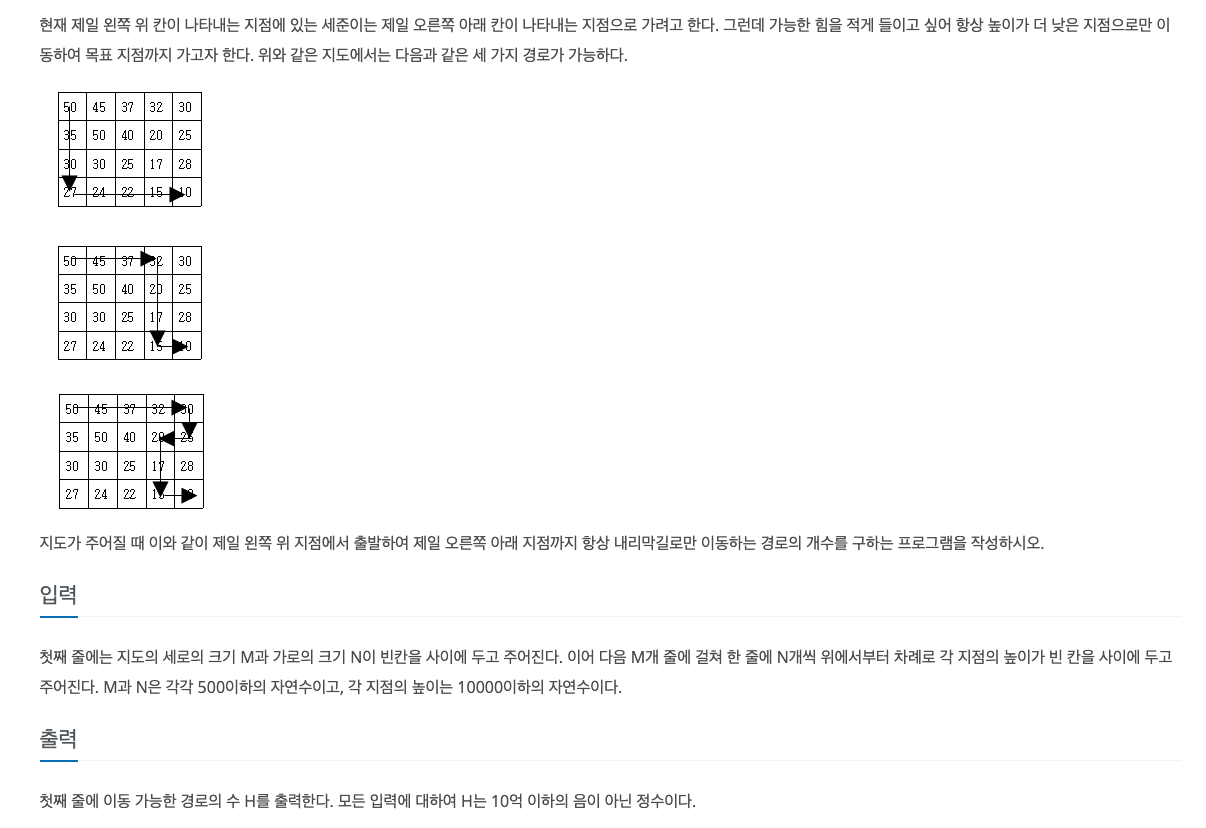내리막길


코드
[ 시간초과 코드 ]
#include <vector>
#include <queue>
#include <iostream>
#include <cmath>
#include <algorithm>
#include <deque>
#include <numeric>
#include <map>
#include <stack>
#define ll long long
using namespace std;
int M,N,ans;
int board[550][550];
int dx[4] = {0, 1, 0, -1};
int dy[4] = {1, 0, -1, 0};
struct info{
int y;
int x;
};
stack<info> s;
int main() {
ios::sync_with_stdio(0);
cin.tie(0);
cout.tie(0);
cin >> M >> N;
for(int i=0;i<M;i++)
for(int j=0;j<N;j++)
cin >> board[i][j];
info t = {0, 0};
s.push(t);
while(!s.empty())
{
auto cur = s.top(); s.pop();
for(int dir=0;dir<4;dir++)
{
int ny = cur.y + dy[dir];
int nx = cur.x + dx[dir];
if(nx<0 or ny<0 or ny>=M or nx>=N) continue;
if(board[ny][nx] >= board[cur.y][cur.x]) continue;
if(ny == M-1 and nx == N-1)
{
ans++;
continue;
}
info t = {ny, nx};
s.push(t);
}
}
cout << ans;
return 0;
}
- 원리
갈 수 있는 모든 경로를 재귀 DFS라면 백트래킹을 통해서 쉽게 해결했을 것이다- 하지만
N과 M이 커서 재귀가 힘들다고 생각해서 stack을 이용한 DFS를 수행
: 중요한 것은 어차피 낮은 곳으로만 이동하기 때문에 왔던 경로로는 절대 갈 수 없음
--> BFS든 DFS든 vis[][]없이 수행만 하면 모든경로의 수를 구할 수 있음
- 문제점
: 모든 점에 대해서 4방향을 수행하기 때문에 이론상 최대 4^(500*500)의 경우의 수로 시간초과가 발생
[ DP적용 코드 ]
#include <vector>
#include <queue>
#include <iostream>
#include <cmath>
#include <algorithm>
#include <deque>
#include <numeric>
#include <map>
#include <stack>
#define ll long long
using namespace std;
int M,N,ans;
int board[550][550];
int dp[550][550];
int dx[4] = {0, 1, 0, -1};
int dy[4] = {1, 0, -1, 0};
struct info{
int y;
int x;
};
int DFS(int y, int x){
if(dp[y][x] != -1) return dp[y][x];
if(y == M-1 and x == N-1) return 1;
dp[y][x] = 0;
for(int dir=0;dir<4;dir++)
{
int ny = y + dy[dir];
int nx = x + dx[dir];
if(nx<0 or ny<0 or nx>=N or ny>=M) continue;
if(board[ny][nx] >= board[y][x]) continue;
if(dp[ny][nx] != -1){
dp[y][x] += dp[ny][nx];
}else{
dp[y][x] += DFS(ny,nx);
}
}
return dp[y][x];
}
int main() {
ios::sync_with_stdio(0);
cin.tie(0);
cout.tie(0);
cin >> M >> N;
for(int i=0;i<M;i++)
for(int j=0;j<N;j++)
{
cin >> board[i][j];
dp[i][j] = -1;
}
ans = DFS(0,0);
cout << ans;
return 0;
}
- 문제 풀이
DFS + DP를 이용해서 이미 검증한 경로에 대해서는 중복을 생략할 수 있음DP[r][c] = r행 c열에서 (M-1, N-1)로 가는 경우의 수
(주의 : DP는 초기에 -1로 세팅 해야 한다. --> 경로의 수가 0인지 아직 구하지 않은건지 구별하기 위함)
- 느낀 점
중복된 경로를 제거해야 한다는 것은 느꼈지만, 방법을 떠올리기 어려웠다DFS와 DP의 조합으로 중복 경로를 제거할 수 있음을 깨달았다


